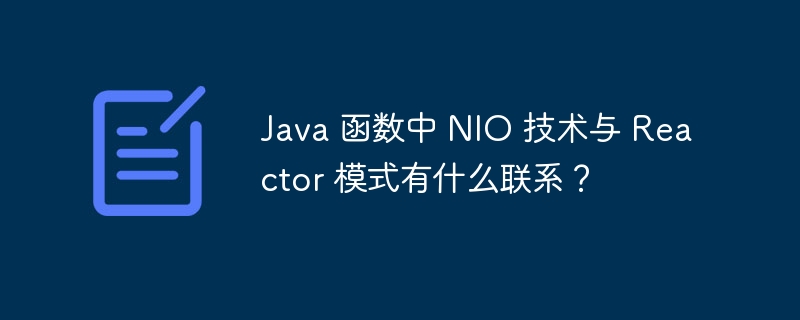

NIO technology and Reactor mode in Java functions
NIO (non-blocking I/O) and Reactor mode are important in Java concurrent programming technology. In Java functions, they are widely used through the Netty framework.
NIO Technology
NIO is a non-blocking I/O model. Unlike traditional blocking I/O, NIO does not block the calling thread, but notifies the application through a callback mechanism when the I/O operation is ready. This enables applications to handle multiple I/O operations simultaneously, improving concurrency.
In Java functions, NIO usually uses classes in the java.nio.channels package. The sample code is as follows:
import java.nio.channels.AsynchronousSocketChannel;
import java.nio.channels.CompletionHandler;
CompletionHandler<Void, Object> completionHandler = new CompletionHandler<Void, Object>() {
@Override
public void completed(Void result, Object attachment) {
// I/O 操作完成时的处理逻辑
}
@Override
public void failed(Throwable exc, Object attachment) {
// I/O 操作失败时的处理逻辑
}
};
final AsynchronousSocketChannel socketChannel = AsynchronousSocketChannel.open();
socketChannel.connect(new InetSocketAddress(host, port), null, completionHandler);Reactor pattern
The Reactor pattern is an event-driven pattern that uses one or more Reactors to handle input from multiple I/O channels event. Reactor is essentially a loop that continuously polls registered channels to check whether there are ready I/O operations.
In Java functions, the Netty framework provides an implementation of the Reactor pattern. EventLoop in Netty is a single-threaded Reactor that handles events from multiple Channels. The sample code is as follows:
import io.netty.bootstrap.Bootstrap;
import io.netty.channel.Channel;
import io.netty.channel.ChannelInitializer;
import io.netty.channel.EventLoopGroup;
import io.netty.channel.nio.NioEventLoopGroup;
import io.netty.channel.socket.SocketChannel;
import io.netty.channel.socket.nio.NioSocketChannel;
import io.netty.handler.codec.http.HttpServerCodec;
import io.netty.handler.codec.http.HttpServerHandler;
public class NettyHttpServer {
public static void main(String[] args) {
EventLoopGroup eventLoopGroup = new NioEventLoopGroup();
try {
Bootstrap bootstrap = new Bootstrap();
bootstrap.group(eventLoopGroup)
.channel(NioSocketChannel.class)
.handler(new ChannelInitializer<SocketChannel>() {
@Override
public void initChannel(SocketChannel channel) {
channel.pipeline().addLast(new HttpServerCodec(), new HttpServerHandler());
}
});
Channel channel = bootstrap.bind(8080).sync().channel();
channel.closeFuture().sync();
} catch (InterruptedException e) {
e.printStackTrace();
} finally {
eventLoopGroup.shutdownGracefully();
}
}
}Practical case
In the following practical case, we will use the Netty framework to build a simple HTTP server. The server will use NIO technology to handle requests from the client, and use the Reactor pattern to assign the request to a single-threaded Reactor for processing.
Steps:
NettyHttpServer class that will start the Netty server. initChannel method, add HttpServerCodec and HttpServerHandler to the Channel pipeline. These handlers will handle the encoding and decoding of HTTP requests and responses. bind(8080).sync().channel() to bind the server to port 8080. Conclusion:
In Java functions, NIO technology and Reactor pattern are widely used through the Netty framework. This enables applications to handle I/O operations in a non-blocking manner and handle events from multiple Channels through a single-threaded Reactor. This approach improves application concurrency and scalability.
The above is the detailed content of What is the connection between NIO technology and Reactor pattern in Java functions?. For more information, please follow other related articles on the PHP Chinese website!




